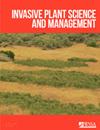Planting native trees to restore riparian forests increases biotic resistance to nonnative plant invasions
IF 1.2
4区 生物学
Q3 PLANT SCIENCES
引用次数: 2
Abstract
Abstract Nonnative invasive plant species are a major cause of ecosystem degradation and impairment of ecosystem service benefits in the United States. Forested riparian areas provide many ecosystem service benefits and are vital to maintaining water quality of streams and rivers. These systems are also vulnerable to natural disturbances and invasion by nonnative plants. We assessed whether planting native trees on disturbed riparian sites may increase biotic resistance to invasive plant establishment in central Vermont in the northeastern United States. The density (stems per square meter) of invasive stems was higher in non-planted sites (x = 4.1 stems m-2) compared with planted sites (x = 1.3 stems m-2). More than 90% of the invasive plants were Japanese knotweed [Fallopia japonica (Houtt.) Ronse Decr.; syn. Polygonum cuspidatum Siebold & Zucc.]. There were no significant differences in total stem density of native vegetation between planted and non-planted sites. Other measured response variables such as native tree regeneration, species diversity, soil properties, and soil function showed no significant differences or trends in the paired riparian study sites. The results of this case study indicate that tree planting in disturbed riparian forest areas may assist conservation efforts by minimizing the risk of invasive plant colonization.种植本地树木来恢复河岸森林可以增加生物对外来植物入侵的抵抗力
摘要外来入侵植物是美国生态系统退化和生态系统服务效益受损的主要原因。森林河岸区提供了许多生态系统服务效益,对维持溪流和河流的水质至关重要。这些系统也容易受到自然干扰和外来植物的入侵。在美国东北部佛蒙特州中部,我们评估了在受干扰的河岸地点种植本地树木是否会增加生物对入侵植物的抗性。非人工地入侵茎密度(x = 4.1茎m-2)高于人工地(x = 1.3茎m-2)。超过90%的入侵植物为日本结叶(Fallopia japonica, Houtt.)。Ronse 12月。[同]虎杖[西博尔德和朱克]。原生植被总茎密度在人工地与非人工地之间无显著差异。其他测量的响应变量,如原生树木更新、物种多样性、土壤性质和土壤功能,在成对的河岸研究地点没有显着差异或趋势。本案例研究的结果表明,在受干扰的河岸森林地区植树造林可以通过减少入侵植物定植的风险来帮助保护工作。
本文章由计算机程序翻译,如有差异,请以英文原文为准。
求助全文
约1分钟内获得全文
求助全文
来源期刊

Invasive Plant Science and Management
PLANT SCIENCES-
CiteScore
2.20
自引率
9.10%
发文量
24
审稿时长
6-12 weeks
期刊介绍:
Invasive Plant Science and Management (IPSM) is an online peer-reviewed journal focusing on fundamental and applied research on invasive plant biology, ecology, management, and restoration of invaded non-crop areas, and on other aspects relevant to invasive species, including educational activities and policy issues. Topics include the biology and ecology of invasive plants in rangeland, prairie, pasture, wildland, forestry, riparian, wetland, aquatic, recreational, rights-of-ways, and other non-crop (parks, preserves, natural areas) settings; genetics of invasive plants; social, ecological, and economic impacts of invasive plants and their management; design, efficacy, and integration of control tools; land restoration and rehabilitation; effects of management on soil, air, water, and wildlife; education, extension, and outreach methods and resources; technology and product reports; mapping and remote sensing, inventory and monitoring; technology transfer tools; case study reports; and regulatory issues.
 求助内容:
求助内容: 应助结果提醒方式:
应助结果提醒方式:


